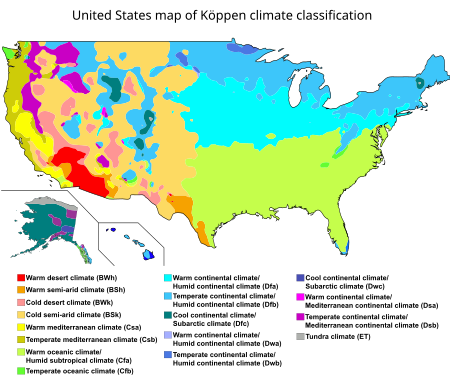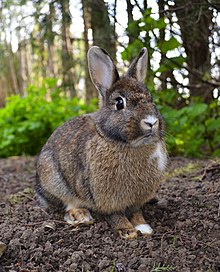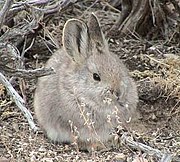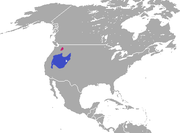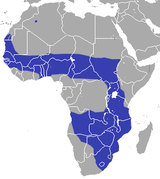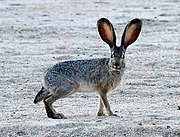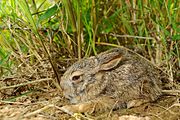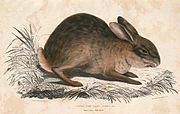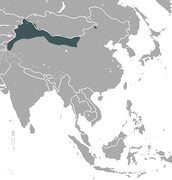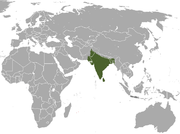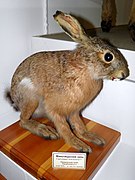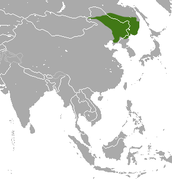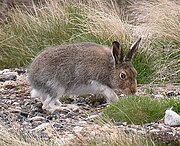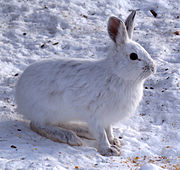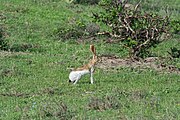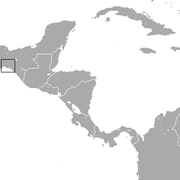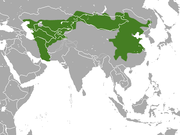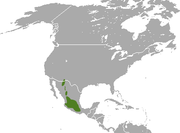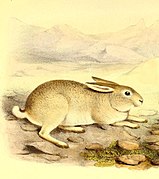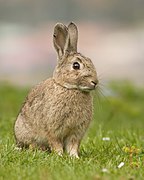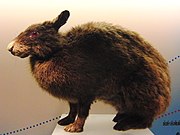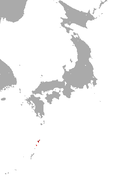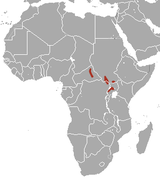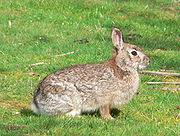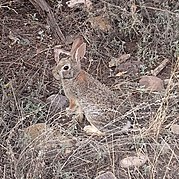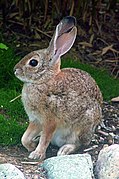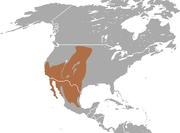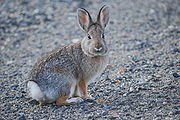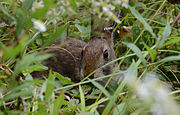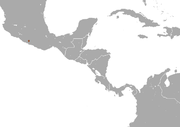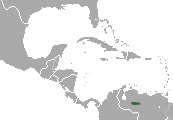List of leporids
Species in mammal family Leporidae
European rabbit (Oryctolagus cuniculus )Leporidae is a family of small mammals in the order Lagomorpha . A member of this family is called a leporid, or colloquially a hare or rabbit . They are widespread worldwide, and can be found in most terrestrial biomes, though primarily in forests, savannas, shrublands, and grasslands. Leporids are all roughly the same shape and fall within a small range of sizes with short tails, ranging from the 21 cm (8 in) long Tres Marias cottontail to the 76 cm (30 in) long desert hare . Most species do not have population estimates and some are not yet evaluated for conservation status , though nine species are considered endangered and one, the riverine rabbit , is critically endangered with a population size of as low as 100. The domestic rabbit subspecies of the European rabbit has been domesticated.
The 64 extant species of Leporidae are contained within 11 genera . One genus, Lepus , contains 32 species that are collectively referred to as hares; the other eight genera are generally referred to as rabbits, with the majority – 19 species – in Sylvilagus [ 1]
Conventions
Conservation status codes listed follow the International Union for Conservation of Nature (IUCN) Red List of Threatened Species . Range maps are provided wherever possible; if a range map is not available, a description of the leporid's range is provided. Ranges are based on the IUCN Red List for that species unless otherwise noted. All extinct species or subspecies listed alongside extant species went extinct after 1500 CE, and are indicated by a dagger symbol "†".
Classification
The family Leporidae consists of 64 extant species in 11 genera which are divided into over 200 extant subspecies. This does not include hybrid species or extinct prehistoric species.
Leporids
The following classification is based on the taxonomy described by Mammal Species of the World molecular phylogenetic analysis , as supported by both the IUCN and the American Society of Mammalogists .[ 2]
Genus Brachylagus Miller , 1900
Common name
Scientific name and subspecies
Range
Size and ecology
IUCN status and estimated population
Pygmy rabbit
B. idahoensis (Merriam , 1891)
Western America (introduced in red)
Size : 23–30 cm (9–12 in) long, plus 1–3 cm (0.4–1.2 in) tail[ 3] Habitat : Shrubland and desert[ 4] Diet : Sagebrush , as well as grass and other plants[ 3] LC [ 4]
Genus Bunolagus Thomas , 1929
Common name
Scientific name and subspecies
Range
Size and ecology
IUCN status and estimated population
Riverine rabbit
B. monticularis (Thomas , 1903)
Southern South Africa
Size : 33–47 cm (13–19 in) long, plus 7–11 cm (3–4 in) tail[ 5] Habitat : Shrubland[ 6] Diet : Shrubs as well as grass[ 6] CR [ 6]
Genus Caprolagus Blyth , 1845
Common name
Scientific name and subspecies
Range
Size and ecology
IUCN status and estimated population
Hispid hare
C. hispidus (Blyth , 1845)
Himalayas Size : 38–50 cm (15–20 in) long, plus 2–4 cm (1–2 in) tail[ 7] Habitat : Grassland and inland wetlands[ 8] Diet : Grass as well as other plants[ 8] EN [ 8]
Genus Lepus Linnaeus , 1758
Common name
Scientific name and subspecies
Range
Size and ecology
IUCN status and estimated population
Abyssinian hare
L. habessinicus Hemprich , Ehrenberg , 1832
L. h. angolensis
L. h. microtis
L. h. senegalensis
L. h. whytei
Horn of Africa Size : 44–45 cm (17–18 in) long[ 9] Habitat : Savanna, grassland, and desert[ 10] Diet : Grass, shrubs, and forbs [ 9] LC [ 10]
African savanna hare
L. victoriae Heuglin , 1865Sub-Saharan Africa Size : 41–58 cm (16–23 in) long[ 11] Habitat : Savanna, shrubland, and grassland[ 12] Diet : Variety of plants[ 12] LC [ 12]
Alaskan hare
L. othus Merriam , 1900
L. o. othus
L. o. tschuktschorum
Western Alaska
Size : 50–60 cm (20–24 in) long, plus 6–11 cm (2–4 in) tail[ 13] Habitat : Forest, shrubland, and grassland[ 14] Diet : Dwarf willow , grass, sedges , and other plants[ 14] LC [ 14]
Antelope jackrabbit
L. alleni Mearns , 1890
L. a. alleni
L. a. palitans
L. a. tiburonensis
Southwestern North America
Size : 43–70 cm (17–28 in) long, plus 5–14 cm (2–6 in) tail[ 15] Habitat : Shrubland, grassland, and desert[ 16] Diet : Grass, velvet mesquite , and cacti[ 16] LC [ 16]
Arctic hare
L. arcticus Ross , 1819
L. a. arcticus
L. a. bangsii
L. a. groenlandicus
L. a. monstrabilis
Arctic North America
Size : 56–66 cm (22–26 in) long, plus 4–10 cm (2–4 in) tail[ 17] Habitat : Forest, shrubland, and grassland[ 18] Diet : Woody plants[ 18] LC [ 18]
Black jackrabbit
L. insularis Bryant , 1891Tip of Baja California
Size : 54–61 cm (21–24 in) long, plus 6–12 cm (2–5 in) tail[ 19] Habitat : Shrubland, grassland, caves, desert, and coastal marine[ 20] Diet : Grass, as well as tree bark[ 21] VU [ 20]
Black-tailed jackrabbit
L. californicus Gray , 1837
L. c. californicus
L. c. deserticola
L. c. insularis
L. c. magdalenae
L. c. melanotis
L. c. texianus
Western and central North America
Size : 47–63 cm (19–25 in) long, plus 5–12 cm (2–5 in) tail[ 22] Habitat : Forest, savanna, shrubland, grassland, and desert[ 23] Diet : Grass and herbs, as well as twigs and bark[ 22] LC [ 23]
Broom hare
L. castroviejoi Arribas , 1977Northern Spain
Size : 41–59 cm (16–23 in) long[ 24] Habitat : Forest and shrubland[ 25] Diet : Grass, herbs, field crops, twigs, buds, and bark[ 25] VU [ 25]
Burmese hare
L. peguensis Blyth , 1855
L. p. peguensis
L. p. vassali
Southeastern Asia
Size : 40–59 cm (16–23 in) long, plus 5–9 cm (2–4 in) tail[ 26] Habitat : Forest, savanna, shrubland, and grassland[ 27] Diet : Grass, bark and twigs[ 27] LC [ 27]
Cape hare
L. capensis Linnaeus , 1758
L. c. aegyptius
L. c. aquilo
L. c. arabicus
L. c. atlanticus
L. c. capensis
L. c. carpi
L. c. granti
L. c. hawkeri
L. c. isabellinus
L. c. schlumbergeri
L. c. sinaiticus
L. c. whitakeri
Africa and western Asia
Size : 52–60 cm (20–24 in) long[ 28] Habitat : Shrubland, grassland, and desert[ 29] Diet : Grass, shrubs, and herbs[ 29] LC [ 29]
Chinese hare
L. sinensis Gray , 1832
L. s. formosus
L. s. sinensis
L. s. yuenshanensis
Southeastern China and Taiwan
Size : 36–42 cm (14–17 in) long, plus 17 cm (7 in) tail[ 30] Habitat : Shrubland and grassland[ 31] Diet : Leafy plants, green shoots, and twigs[ 31] LC [ 31]
Corsican hare
L. corsicanus Winton , 1898Southern Italy
Size : 55–61 cm (22–24 in) long[ 32] Habitat : Forest, shrubland, grassland, and coastal marine[ 33] Diet : Grass, as well as mint, sedges, rushes, peas, and flowers[ 32] VU [ 33]
Desert hare
L. tibetanus Waterhouse , 1841
L. t. centrasiaticus
L. t. craspedotis
L. t. pamirensis
L. t. stoliczkanus
L. t. tibetanus
Northwestern China
Size : 40–76 cm (16–30 in) long[ 34] Habitat : Shrubland, grassland, and desert[ 35] Diet : Variety of plants as well as seeds, berries, roots, and twigs[ 34] LC [ 35]
Ethiopian hare
L. fagani Thomas , 1903Ethiopia Size : 42–50 cm (17–20 in) long, plus 7–11 cm (3–4 in) tail[ 36] Habitat : Savanna, shrubland, and grassland[ 37] Diet : Unknown plants[ 37] LC [ 37]
Ethiopian highland hare
L. starcki Petter , 1963Central Ethiopia
Size : 46–60 cm (18–24 in) long, plus 7–12 cm (3–5 in) tail[ 38] Habitat : Shrubland and grassland[ 39] Diet : Grass as well as shrubs[ 39] LC [ 39]
European hare
L. europaeus Pallas , 1778
L. e. caspicus
L. e. connori
L. e. creticus
L. e. cyprius
L. e. cyrensis
L. e. europaeus
L. e. hybridus
L. e. judeae
L. e. karpathorum
L. e. medius
L. e. occidentalis
L. e. parnassius
L. e. ponticus
L. e. rhodius
L. e. syriacus
L. e. transsylvanicus
Europe, western Asia, northeastern North America, southern South America, eastern Oceana (introduced in light red)
Size : 60–75 cm (24–30 in) long, plus 7–11 cm (3–4 in) tail[ 40] Habitat : Shrubland and grassland[ 41] Diet : Grass, herbs, field crops, twigs, buds, and bark[ 40] LC [ 41]
Granada hare
L. granatensis Rosenhauer , 1856Iberian Peninsula (introduced in pink)Size : 44–48 cm (17–19 in) long, plus 9–12 cm (4–5 in) tail[ 42] Habitat : Forest, shrubland, and grassland[ 43] Diet : Buds, twigs, bark, and crops[ 44] LC [ 43]
Hainan hare
L. hainanus Swinhoe , 1870Hainan Island, ChinaSize : 35–40 cm (14–16 in) long, plus 4–7 cm (2–3 in) tail[ 45] Habitat : Shrubland and grassland[ 46] Diet : Plants[ 47] EN [ 46]
Indian hare
L. nigricollis F. Cuvier , 1823
L. n. aryabertensis
L. n. dayanus
L. n. nigricollis
L. n. ruficaudatus
L. n. sadiya
L. n. simcoxi
L. n. singhala
Indian subcontinent Size : 40–70 cm (16–28 in) long[ 48] Habitat : Forest, shrubland, grassland, inland wetlands, and desert[ 49] Diet : Grass and flowering plants[ 48] LC [ 49]
Japanese hare
L. brachyurus Temminck , 1845
L. b. angustidens
L. b. brachyurus
L. b. lyoni
L. b. okiensis
Japan
Size : 45–54 cm (18–21 in) long, plus 2–5 cm (1–2 in) tail[ 50] Habitat : Forest, shrubland, and grassland[ 51] Diet : Grass, buds, seedlings, and shrubs[ 52] LC [ 51]
Korean hare
L. coreanus Thomas , 1892Korea
Size : 45–54 cm (18–21 in) long, plus 2–5 cm (1–2 in) tail[ 53] Habitat : Shrubland and grassland[ 54] Diet : Grass, shrubs, and bark[ 53] LC [ 54]
Manchurian hare
L. mandshuricus Radde , 1861Eastern Asia
Size : 41–54 cm (16–21 in) long, plus 5–8 cm (2–3 in) tail[ 55] Habitat : Forest[ 56] Diet : Bark and twigs, as well as shrubs, herbs, and fruit[ 57] LC [ 56]
Mountain hare
L. timidus Linnaeus , 1758
L. t. ainu
L. t. begitschevi
L. t. gichiganus
L. t. hibernicus
L. t. kamtschaticus
L. t. kolymensis
L. t. kozhevnikovi
L. t. lugubris
L. t. mordeni
L. t. orii
L. t. scoticus
L. t. sibiricorum
L. t. timidus
L. t. transbaicalicus
L. t. varronis
Europe and northern Asia
Size : 50–55 cm (20–22 in) long, plus 5–7 cm (2–3 in) tail[ 58] Habitat : Forest, shrubland, grassland, and inland wetlands[ 59] Diet : Seeds, berries, roots, twigs, and other plants[ 58] LC [ 59]
Scrub hare
L. saxatilis F. Cuvier , 1823
L. s. saxatilis
L. s. subrufus
Southern Africa
Size : 45–65 cm (18–26 in) long[ 60] Habitat : Savanna, shrubland, grassland, and desert[ 61] Diet : Grass[ 61] LC [ 61]
Snowshoe hare
L. americanus Erxleben , 1777
L. a. americanus
L. a. bairdii
L. a. cascadensis
L. a. dalli
L. a. struthopus
L. a. virginianus
Northern North America
Size : 38–51 cm (15–20 in) long, plus 4–6 cm (1.6–2.4 in) tail[ 62] Habitat : Forest and shrubland[ 63] Diet : Grass, forbs, sedges, and ferns[ 63] LC [ 63]
Tehuantepec jackrabbit
L. flavigularis Wagner , 1844Small region of southern Mexico
Size : 56–61 cm (22–24 in) long[ 64] Habitat : Savanna, shrubland, grassland, and coastal marine[ 65] Diet : Grass, as well as other plants[ 64] EN [ 65]
Tolai hare
L. tolai Pallas , 1778
L. t. aurigineus
L. t. buchariensis
L. t. cheybani
L. t. cinnamomeus
L. t. filchneri
L. t. lehmanni
L. t. swinhoei
L. t. tolai
Central and eastern Asia
Size : 40–59 cm (16–23 in) long, plus 7–11 cm (3–4 in) tail[ 66] Habitat : Grassland and rocky areas[ 67] Diet : Roots, grass, and herbs[ 67] LC [ 67]
White-sided jackrabbit
L. callotis Wagler , 1830
L. c. callotis
L. c. gaillardi
Southern North America
Size : 43–60 cm (17–24 in) long, plus 4–10 cm (2–4 in) tail[ 68] Habitat : Shrubland and grassland[ 69] Diet : Grass and sedges[ 68] VU [ 69]
White-tailed jackrabbit
L. townsendii Bachman , 1839
L. t. campanius
L. t. townsendii
Central and northern North America
Size : 53–60 cm (21–24 in) long[ 70] Habitat : Shrubland and grassland[ 71] Diet : Grass and forbs, as well as shrubs[ 71] LC [ 71]
Woolly hare
L. oiostolus Hodgson , 1840
L. o. hypsibius
L. o. oiostolus
L. o. pallipes
L. o. przewalskii
Central Asia
Size : 40–50 cm (16–20 in) long, plus 9 cm (4 in) tail[ 72] Habitat : Shrubland, grassland, and desert[ 73] Diet : Grass and leaves, as well as fruit and crops[ 72] LC [ 73]
Yarkand hare
L. yarkandensis Günther , 1875Western China
Size : 28–43 cm (11–17 in) long, plus 5–9 cm (2–4 in) tail[ 74] Habitat : Forest and shrubland[ 75] Diet : Grass and crops[ 75] NT [ 75]
Yunnan hare
L. comus Allen , 1927Southern China
Size : 28–43 cm (11–17 in) long, plus 5–9 cm (2–4 in) tail[ 76] Habitat : Grassland[ 77] Diet : Forbs and shrubs[ 78] LC [ 77]
Genus Oryctolagus Lilljeborg , 1762
Common name
Scientific name and subspecies
Range
Size and ecology
IUCN status and estimated population
European rabbit
O. cuniculus (Linnaeus , 1758)
O. c. algirus (Iberian rabbit)
O. c. brachyotus (Camargue rabbit)
O. c. cnossius (Cretan rabbit)
O. c. cuniculus (Common rabbit)
O. c. domesticus (Domestic rabbit )
O. c. habetensis (African rabbit)
O. c. huxleyi (Mediterranean rabbit)
Europe, southern South America, and Oceana (introduced in pink)
Size : 38–50 cm (15–20 in) long[ 82] Habitat : Forest, savanna, shrubland, and grassland[ 83] Diet : Grass, leaves, buds, bark, and roots[ 82] EN [ 83]
Genus Pentalagus Lyon , 1904
Common name
Scientific name and subspecies
Range
Size and ecology
IUCN status and estimated population
Amami rabbit
P. furnessi (Stone , 1900)
Southern tip of Japan
Size : 39–53 cm (15–21 in) long, plus 2–4 cm (1–2 in) tail[ 84] Habitat : Forest, shrubland, and intertidal marine[ 85] Diet : Herbs, shrubs, and acorns[ 85] EN [ 85]
Genus Poelagus St. Leger , 1932
Common name
Scientific name and subspecies
Range
Size and ecology
IUCN status and estimated population
Bunyoro rabbit
P. marjorita (St. Leger , 1929)
Central Africa
Size : 45–50 cm (18–20 in) long, plus 4–5 cm (1.6–2.0 in) tail[ 86] Habitat : Forest, savanna, and rocky areas[ 87] Diet : Grass, shrubs, forbs, and tubers [ 86] LC [ 87]
Genus Pronolagus Lyon , 1904
Common name
Scientific name and subspecies
Range
Size and ecology
IUCN status and estimated population
Hewitt's red rock hare
P. saundersiae Hewitt , 1927Southern Africa
Size : 38–54 cm (15–21 in) long, plus 5–12 cm (2–5 in) tail[ 88] Habitat : Shrubland, grassland, and rocky areas[ 89] Diet : Grass[ 88] LC [ 89]
Jameson's red rock hare
P. randensis Jameson , 1907
P. r. caucinus
P. r. randensis
P. r. whitei
Southern Africa
Size : 42–50 cm (17–20 in) long[ 90] Habitat : Shrubland, grassland, and rocky areas[ 91] Diet : Grass[ 90] LC [ 91]
Natal red rock hare
P. crassicaudatus (Geoffroy , 1832)
P. c. crassicaudatus
P. c. ruddi
Southern Africa
Size : 46–56 cm (18–22 in) long, plus 3–11 cm (1–4 in) tail[ 92] Habitat : Shrubland, grassland, and rocky areas[ 93] Diet : Grass[ 92] LC [ 93]
Smith's red rock hare
P. rupestris Smith , 1834
P. r. curryi
P. r. nyikae
P. r. rupestris
P. r. saundersiae
P. r. vallicola
Southern Africa
Size : 38–54 cm (15–21 in) long, plus 5–12 cm (2–5 in) tail[ 94] Habitat : Grassland, rocky areas, and desert[ 95] Diet : Grass, herbs, and shrubs[ 96] LC [ 95]
Genus Romerolagus Merriam , 1896
Common name
Scientific name and subspecies
Range
Size and ecology
IUCN status and estimated population
Volcano rabbit
R. diazi (Ferrari-Pérez , 1893)
Southern Mexico
Size : 27–32 cm (11–13 in) long, plus 1–4 cm (0.4–1.6 in) tail[ 97] Habitat : Forest and grassland[ 98] Diet : Grass[ 97] EN [ 98]
Genus Sylvilagus Gray , 1867
Common name
Scientific name and subspecies
Range
Size and ecology
IUCN status and estimated population
Andean tapeti
S. andinus (Thomas , 1897)
Northern Andes
Size : 33–36 cm (13–14 in) long, plus 2–4 cm (1–2 in) tail[ 99] Habitat : Grassland[ 100] Diet : Grass and sedges[ 100] DD [ 100]
Appalachian cottontail
S. obscurus Chapman , Cramer , Dippenaar , Robinson , 1992Eastern America
Size : 32–41 cm (13–16 in) long, plus 2–7 cm (1–3 in) tail[ 101] Habitat : Forest, shrubland, and inland wetlands[ 102] Diet : Ferns, grass, forbs, shrubs, and conifer needles[ 102] NT [ 102]
Brush rabbit
S. bachmani (Waterhouse , 1839)
S. b. bachmani
S. b. cerrosensis
S. b. cinerascens
S. b. exiguus
S. b. howelli
S. b. ubericolor
Western North America
Size : 30–37 cm (12–15 in) long, plus 1–3 cm (0.4–1.2 in) tail[ 103] Habitat : Forest, shrubland, grassland, inland wetlands, and desert[ 104] Diet : Grass, as well as other plants[ 104] LC [ 104]
Central American tapeti
S. gabbi (Allen , 1877)
Central America
Size : Unknown[ 105] Habitat : Forest[ 106] Diet : Unknown plants[ 105] LC [ 106]
Coastal tapeti
S. tapetillus Thomas , 1913Rio de Janeiro , Brazil
Size : Unknown[ 107] Habitat : Grassland[ 108] Diet : Unknown plants[ 107] VU [ 108]
Common tapeti
S. brasiliensis (Linnaeus , 1758)
S. b. apollinaris (Bogota tapeti)
S. b. brasiliensis
S. b. capsalis
S. b. caracasensis
S. b. chillae
S. b. chotanus
S. b. defilippi
S. b. fulvescens (Fulvous tapeti)
S. b. gibsoni
S. b. inca
S. b. kelloggi
S. b. meridensis
S. b. minensis
S. b. paraguensis
S. b. peruanus
S. b. surdaster (Western tapeti )
S. b. truei
Northeastern Brazil
Size : Unknown[ 105] Habitat : Forest[ 109] Diet : Unknown plants[ 105] EN [ 109]
Davis Mountains cottontail
S. robustus Bailey , 1905Mexico and southern United States
Size : Unknown[ 110] Habitat : Forest[ 110] Diet : Unknown plants[ 110] VU [ 110]
Desert cottontail
S. audubonii (Baird , 1858)
S. a. arizonae
S. a. audubonii
S. a. baileyi
S. a. confinis
S. a. goldmani
S. a. minor
S. a. warreni
Western North America
Size : 37–40 cm (15–16 in) long, plus 5–6 cm (2.0–2.4 in) tail[ 111] Habitat : Forest, shrubland, grassland, and desert[ 112] Diet : Forbs, grass, and shrubs[ 112] LC [ 112]
Dice's cottontail
S. dicei Harris Jr. , 1932Costa Rica and Panama Size : 34–45 cm (13–18 in) long, plus 2–4 cm (1–2 in) tail[ 113] Habitat : Forest, shrubland, and grassland[ 114] Diet : Unknown plants[ 113] VU [ 114]
Eastern cottontail
S. floridanus (Allen , 1890)
S. f. alacer
S. f. avius
S. f. aztecus
S. f. chapmani
S. f. connectens
S. f. cumanicus
S. f. floridanus
S. f. hesperius
S. f. holzneri (Robust cottontail )
S. f. hondurensis
S. f. macrocorpus
S. f. mallurus
S. f. margaritae
S. f. nigronuchalis
S. f. orinoci
S. f. orizabae
S. f. purgatus
S. f. superciliaris
S. f. yucatanicus
North America, Central America, and northern South America
Size : 39–48 cm (15–19 in) long, plus 2–7 cm (1–3 in) tail[ 115] Habitat : Forest, savanna, shrubland, grassland, inland wetlands, rocky areas, and desert[ 116] Diet : Variety of plants[ 116] LC [ 116]
Marsh rabbit
S. palustris (Bachman , 1837)
S. p. paludicola (Florida marsh rabbit)
S. p. palustris (Carolina marsh rabbit)
S. p. hefneri Eastern America
Size : 42–44 cm (17–17 in) long[ 117] Habitat : Forest, grassland, inland wetlands, and intertidal marine[ 118] Diet : Berries, rhizomes , bulbs, grass, and other plants[ 117] LC [ 118]
Mexican cottontail
S. cunicularius (Horsfield , 1848)
S. c. cunicularius
S. c. insolitus
Southern Mexico
Size : 48–52 cm (19–20 in) long, plus 5–7 cm (2–3 in) tail[ 119] Habitat : Forest, shrubland, grassland, and desert[ 120] Diet : Unknown plants[ 119] LC [ 120]
Mountain cottontail
S. nuttallii (Bachman , 1837)
S. n. grangeri
S. n. nuttallii
S. n. pinetis
Western North America
Size : 28–36 cm (11–14 in) long, plus 3–6 cm (1–2 in) tail[ 121] Habitat : Forest and shrubland[ 122] Diet : Sagebrush and grass[ 123] LC [ 122]
New England cottontail
S. transitionalis (Bangs , 1895)
New England Size : 39–44 cm (15–17 in) long[ 124] Habitat : Forest, shrubland, and inland wetlands[ 125] Diet : Grass, forbs, and twigs[ 124] VU [ 125]
Omilteme cottontail
S. insonus Nelson , 1904Sierra Madre del Sur in MexicoSize : 39–44 cm (15–17 in) long, plus 4–5 cm (1.6–2.0 in) tail[ 126] Habitat : Forest[ 126] Diet : Unknown plants[ 126] DD [ 126]
Santa Marta tapeti
S. sanctaemartae Hershkovitz , 1950Columbia
Size : Unknown[ 105] Habitat : Forest, grassland[ 105] Diet : Unknown plants[ 105] DD [ 127]
Swamp rabbit
S. aquaticus (Bachman , 1837)
S. a. aquaticus
S. a. littoralis
Southern America
Size : 45–55 cm (18–22 in) long, plus 5–8 cm (2–3 in) tail[ 128] Habitat : Forest, shrubland, grassland, and inland wetlands[ 129] Diet : Grass, sedges, shrubs, bark, seedlings, and twigs[ 130] LC [ 129]
Tres Marias cottontail
S. graysoni (Allen , 1877)
Southwestern Mexico
Size : 21–48 cm (8–19 in) long, plus 1–6 cm (0.4–2.4 in) tail[ 131] Habitat : Forest, savanna, and shrubland[ 132] Diet : Wide variety of plants[ 131] EN [ 132]
Venezuelan lowland rabbit
S. varynaensis Durant , Guevara , 2001Venezuela Size : 41–49 cm (16–19 in) long, plus 2–3 cm (0.8–1.2 in) tail[ 133] Habitat : Forest and savanna[ 134] Diet : Sida [ 134] DD [ 134]
References
^ "Fossilworks: Leporidae" . Paleobiology Database University of Wisconsin–Madison . Archived from the original on December 12, 2021. Retrieved December 17, 2021 .^ Wilson, Reeder , pp. 194–211^ a b Rohde, Ashley (2006). "Brachylagus idahoensis " . Animal Diversity Web University of Michigan . Archived from the original on October 23, 2021. Retrieved October 22, 2021 . ^ a b Rachlow, J.; Becker, P. A.; Shipley, L. (2016). "Brachylagus idahoensis " . IUCN Red List of Threatened Species 2016 : e.T2963A45176206. doi :10.2305/IUCN.UK.2016-3.RLTS.T2963A45176206.en ^ Smith, Johnston, Alves, Hackländer , p. 91^ a b c ^ Smith, Johnston, Alves, Hackländer , p. 94^ a b c Aryal, A.; Yadav, B. (2019). "Caprolagus hispidus " . IUCN Red List of Threatened Species 2019 : e.T3833A45176688. doi :10.2305/IUCN.UK.2019-1.RLTS.T3833A45176688.en ^ a b Nickolai, Ashley (2014). "Lepus habessinicus " . Animal Diversity Web University of Michigan . Archived from the original on October 23, 2021. Retrieved October 22, 2021 . ^ a b Johnston, C. H.; Tolesa, Z. (2019). "Lepus habessinicus " . IUCN Red List of Threatened Species 2019 : e.T41289A45189637. doi :10.2305/IUCN.UK.2019-1.RLTS.T41289A45189637.en ^ Riegler, Donald (2013). "Lepus microtis " . Animal Diversity Web University of Michigan . Archived from the original on November 5, 2021. Retrieved November 5, 2021 . ^ a b c Johnston, C. H.; Robinson, T. J.; Relton, C.; Child, M. F.; Smith, A. T. (2019). "Lepus victoriae " . IUCN Red List of Threatened Species 2019 : e.T41879A45194215. doi :10.2305/IUCN.UK.2019-1.RLTS.T41879A45194215.en ^ Smith, Johnston, Alves, Hackländer , p. 204^ a b c Smith, A. T.; Johnston, C. H. (2019). "Lepus othus " . IUCN Red List of Threatened Species 2019 : e.T11795A45178124. doi :10.2305/IUCN.UK.2019-1.RLTS.T11795A45178124.en ^ Smith, Johnston, Alves, Hackländer , p. 160^ a b c Lorenzo, C.; Brown, D. E. (2019). "Lepus alleni " . IUCN Red List of Threatened Species 2019 : e.T41272A45185265. doi :10.2305/IUCN.UK.2019-1.RLTS.T41272A45185265.en ^ Smith, Johnston, Alves, Hackländer , p. 166^ a b c Smith, A. T.; Johnston, C. H. (2019). "Lepus arcticus " . IUCN Red List of Threatened Species 2019 : e.T41274A45185887. doi :10.2305/IUCN.UK.2019-1.RLTS.T41274A45185887.en ^ Smith, Johnston, Alves, Hackländer , p. 198^ a b Lorenzo, C.; Johnston, C. H. (2019). "Lepus insularis " . IUCN Red List of Threatened Species 2019 : e.T11794A45177986. doi :10.2305/IUCN.UK.2019-3.RLTS.T11794A45177986.en ^ Mejia, Joseph R. (1999). "Lepus insularis " . Animal Diversity Web University of Michigan . Archived from the original on October 23, 2021. Retrieved October 22, 2021 . ^ a b Ballenger, Liz (1999). "Lepus californicus " . Animal Diversity Web University of Michigan . Archived from the original on October 23, 2021. Retrieved October 22, 2021 . ^ a b Brown, D. E.; Lorenzo, C.; Álvarez-Castañeda, S. T. (2019). "Lepus californicus " . IUCN Red List of Threatened Species 2019 : e.T41276A45186309. doi :10.2305/IUCN.UK.2019-1.RLTS.T41276A45186309.en ^ Smith, Johnston, Alves, Hackländer , p. 179^ a b c Ballesteros, F.; Smith, A. T. (2019). "Lepus castroviejoi " . IUCN Red List of Threatened Species 2019 : e.T11797A503908. doi :10.2305/IUCN.UK.2019-2.RLTS.T11797A503908.en ^ Smith, Johnston, Alves, Hackländer , p. 205^ a b c Johnston, C. H.; Smith, A. T. (2019). "Lepus peguensis " . IUCN Red List of Threatened Species 2019 : e.T41284A45188632. doi :10.2305/IUCN.UK.2019-1.RLTS.T41284A45188632.en ^ Begnoche, Dana (2002). "Lepus capensis " . Animal Diversity Web University of Michigan . Archived from the original on November 5, 2021. Retrieved November 5, 2021 . ^ a b c Johnston, C. H.; Robinson, T. J.; Child, M. F.; Relton, C. (2019). "Lepus capensis " . IUCN Red List of Threatened Species 2019 : e.T41277A45186750. doi :10.2305/IUCN.UK.2019-1.RLTS.T41277A45186750.en ^ a b Smith, Johnston, Alves, Hackländer , p. 96^ a b c Smith, A. T.; Johnston, C. H. (2019). "Lepus sinensis " . IUCN Red List of Threatened Species 2019 : e.T41286A45189035. doi :10.2305/IUCN.UK.2019-1.RLTS.T41286A45189035.en ^ a b Cooper, Thomas (2015). "Lepus corsicanus " . Animal Diversity Web University of Michigan . Archived from the original on October 23, 2021. Retrieved October 22, 2021 . ^ a b Randi, E.; Riga, F. (2019). "Lepus corsicanus " . IUCN Red List of Threatened Species 2019 : e.T41305A2952954. doi :10.2305/IUCN.UK.2019-2.RLTS.T41305A2952954.en ^ a b Sullivan, Shaunna (2013). "Lepus tibetanus " . Animal Diversity Web University of Michigan . Archived from the original on October 23, 2021. Retrieved October 22, 2021 . ^ a b Smith, A. T.; Johnston, C. H. (2019). "Lepus tibetanus " . IUCN Red List of Threatened Species 2019 : e.T41307A45193298. doi :10.2305/IUCN.UK.2019-1.RLTS.T41307A45193298.en ^ Smith, Johnston, Alves, Hackländer , p. 190^ a b c Johnston, C. H.; Tolesa, Z. (2019). "Lepus fagani " . IUCN Red List of Threatened Species 2019 : e.T11798A45178437. doi :10.2305/IUCN.UK.2019-1.RLTS.T11798A45178437.en ^ Kingdon , p. 310^ a b c Johnston, C. H.; Tolesa, Z. (2019). "Lepus starcki " . IUCN Red List of Threatened Species 2019 : e.T41287A45189235. doi :10.2305/IUCN.UK.2019-1.RLTS.T41287A45189235.en ^ a b Vu, Alan (2001). "Lepus europaeus " . Animal Diversity Web University of Michigan . Archived from the original on October 23, 2021. Retrieved October 22, 2021 . ^ a b Hacklander, K.; Schai-Braun, S. (2019). "Lepus europaeus " . IUCN Red List of Threatened Species 2019 : e.T41280A45187424. doi :10.2305/IUCN.UK.2019-1.RLTS.T41280A45187424.en ^ Smith, Johnston, Alves, Hackländer , p. 193^ a b Soriguer, R.; Carro, F. (2019). "Lepus granatensis " . IUCN Red List of Threatened Species 2019 : e.T41306A2953195. doi :10.2305/IUCN.UK.2019-1.RLTS.T41306A2953195.en ^ Weaver, Derek (2013). "Lepus granatensis " . Animal Diversity Web University of Michigan . Archived from the original on November 5, 2021. Retrieved November 5, 2021 . ^ Smith, Johnston, Alves, Hackländer , p. 197^ a b Smith, A. T.; Johnston, C. (2016). "Lepus hainanus " . IUCN Red List of Threatened Species 2016 : e.T11793A45177783. doi :10.2305/IUCN.UK.2016-3.RLTS.T11793A45177783.en ^ Lundberg, Annette (2013). "Lepus hainanus " . Animal Diversity Web University of Michigan . Archived from the original on November 5, 2021. Retrieved November 5, 2021 . ^ a b ^ a b Nameer, P. O.; Smith, A. T. (2019). "Lepus nigricollis " . IUCN Red List of Threatened Species 2019 : e.T41282A45188041. doi :10.2305/IUCN.UK.2019-1.RLTS.T41282A45188041.en ^ Smith, Johnston, Alves, Hackländer , p. 169^ a b Yamada, F.; Smith, A. T. (2019). "Lepus brachyurus " . IUCN Red List of Threatened Species 2019 : e.T41275A45186064. doi :10.2305/IUCN.UK.2019-1.RLTS.T41275A45186064.en ^ Holmberg, Jennifer (2014). "Lepus brachyurus " . Animal Diversity Web University of Michigan . Archived from the original on November 5, 2021. Retrieved November 5, 2021 . ^ a b Faigle, Stacy (2014). "Lepus coreanus " . Animal Diversity Web University of Michigan . Archived from the original on October 23, 2021. Retrieved October 22, 2021 . ^ a b Jo, Y.-S.; Smith, A. T. (2019) [errata version of 2019 assessment]. "Lepus coreanus " . IUCN Red List of Threatened Species 2019 : e.T41279A161750768. doi :10.2305/IUCN.UK.2019-1.RLTS.T41279A161750768.en ^ Smith, Johnston, Alves, Hackländer , p. 200^ a b Smith, A. T.; Johnston, C. H. (2019). "Lepus mandshuricus " . IUCN Red List of Threatened Species 2019 : e.T41281A45187882. doi :10.2305/IUCN.UK.2019-1.RLTS.T41281A45187882.en ^ Smith, Xie, et al. , p. 289^ a b Smith, Johnston, Alves, Hackländer , pp. 212–213^ a b Smith, A. T.; Johnston, C. H. (2019). "Lepus timidus " . IUCN Red List of Threatened Species 2019 : e.T11791A45177198. doi :10.2305/IUCN.UK.2019-1.RLTS.T11791A45177198.en ^ Kushnereit, Aimee (2004). "Lepus saxatilis " . Animal Diversity Web University of Michigan . Archived from the original on November 5, 2021. Retrieved November 5, 2021 . ^ a b c Robinson, T. J.; Child, M. F.; Relton, C.; Johnston, C. H. (2019). "Lepus saxatilis " . IUCN Red List of Threatened Species 2019 : e.T41285A45188827. doi :10.2305/IUCN.UK.2019-1.RLTS.T41285A45188827.en ^ Smith, Johnston, Alves, Hackländer , p. 163^ a b c Mills, L.; Smith, A. T. (2019). "Lepus americanus " . IUCN Red List of Threatened Species 2019 : e.T41273A45185466. doi :10.2305/IUCN.UK.2019-1.RLTS.T41273A45185466.en ^ a b Warlin, Sierra (2013). "Lepus flavigularis " . Animal Diversity Web University of Michigan . Archived from the original on October 23, 2021. Retrieved October 22, 2021 . ^ a b Lorenzo, C.; Smith, A. T. (2019). "Lepus flavigularis " . IUCN Red List of Threatened Species 2019 : e.T11790A45176906. doi :10.2305/IUCN.UK.2019-3.RLTS.T11790A45176906.en ^ Smith, Xie, et al. , p. 291^ a b c Smith, A. T.; Johnston, C. H. (2019). "Lepus tolai " . IUCN Red List of Threatened Species 2019 : e.T41308A45193447. doi :10.2305/IUCN.UK.2019-1.RLTS.T41308A45193447.en ^ a b Dharmani, Aarti (2000). "Lepus callotis " . Animal Diversity Web University of Michigan . Archived from the original on October 23, 2021. Retrieved October 22, 2021 . ^ a b Brown, D. E.; Smith, A. T. (2019). "Lepus callotis " . IUCN Red List of Threatened Species 2019 : e.T11792A45177499. doi :10.2305/IUCN.UK.2019-2.RLTS.T11792A45177499.en ^ Verts, Carraway , p. 142^ a b c Brown, D. E.; Smith, A. T. (2019). "Lepus townsendii " . IUCN Red List of Threatened Species 2019 : e.T41288A45189364. doi :10.2305/IUCN.UK.2019-1.RLTS.T41288A45189364.en ^ a b Ng, Jarita (2011). "Lepus oiostolus " . Animal Diversity Web University of Michigan . Archived from the original on October 23, 2021. Retrieved October 22, 2021 . ^ a b Smith, A. T.; Johnston, C. H. (2019). "Lepus oiostolus " . IUCN Red List of Threatened Species 2019 : e.T41283A45188432. doi :10.2305/IUCN.UK.2019-1.RLTS.T41283A45188432.en ^ Smith, Xie, et al. , p. 292^ a b c Smith, A. T.; Johnston, C. H. (2017) [errata version of 2016 assessment]. "Lepus yarkandensis " . IUCN Red List of Threatened Species 2016 : e.T11796A115103994. doi :10.2305/IUCN.UK.2016-3.RLTS.T11796A45178274.en ^ Smith, Johnston, Alves, Hackländer , p. 222^ a b Smith, A. T.; Johnston, C. H. (2019). "Lepus comus " . IUCN Red List of Threatened Species 2019 : e.T41278A45187160. doi :10.2305/IUCN.UK.2019-1.RLTS.T41278A45187160.en ^ Smith, Xie, et al. , p. 287^ a b Hoedl, Amanda (2012). "Nesolagus timminsi " . Animal Diversity Web University of Michigan . Archived from the original on October 23, 2021. Retrieved October 22, 2021 . ^ a b Tilker, A.; Timmins, R. J.; Nguyen The Truong, A.; Coudrat, C. N. Z.; Gray, T.; Le Trong Trai, Willcox; D. H. A., Abramov; A. V., Wilkinson; N., Steinmetz; R. (2019). "Nesolagus timminsi " . IUCN Red List of Threatened Species 2019 : e.T41209A45181925. doi :10.2305/IUCN.UK.2019-1.RLTS.T41209A45181925.en ^ a b c McCarthy, J.; Holden, J.; Martyr, D.; McCarthy, K. (2019). "Nesolagus netscheri " . IUCN Red List of Threatened Species 2019 : e.T14662A45178557. doi :10.2305/IUCN.UK.2019-2.RLTS.T14662A45178557.en ^ a b Tislerics, Ati (2000). "Oryctolagus cuniculus " . Animal Diversity Web University of Michigan . Archived from the original on October 23, 2021. Retrieved October 22, 2021 . ^ a b Villafuerte, R.; Delibes-Mateos, M. (2020) [errata version of 2019 assessment]. "Oryctolagus cuniculus " . IUCN Red List of Threatened Species 2019 : e.T41291A170619657. doi :10.2305/IUCN.UK.2019-3.RLTS.T41291A170619657.en ^ Smith, Johnston, Alves, Hackländer , p. 105^ a b c Yamada, F. and Smith; A. T. (2016). "Pentalagus furnessi " . IUCN Red List of Threatened Species 2016 : e.T16559A45180151. doi :10.2305/IUCN.UK.2016-3.RLTS.T16559A45180151.en ^ a b Portman, Charles (2004). "Poelagus marjorita " . Animal Diversity Web University of Michigan . Archived from the original on October 23, 2021. Retrieved October 22, 2021 . ^ a b Johnston, C. H.; Smith, A. T. (2019). "Poelagus marjorita " . IUCN Red List of Threatened Species 2019 : e.T41292A45189965. doi :10.2305/IUCN.UK.2019-1.RLTS.T41292A45189965.en ^ a b Smith, Johnston, Alves, Hackländer , p. 113^ a b Robinson, T. J.; Child, M. F.; Matthee, C. M. (2019). "Pronolagus saundersiae " . IUCN Red List of Threatened Species 2019 : e.T136713A45194657. doi :10.2305/IUCN.UK.2019-1.RLTS.T136713A45194657.en ^ a b Bartel, Riley (2015). "Pronolagus randensis " . Animal Diversity Web University of Michigan . Archived from the original on October 23, 2021. Retrieved October 22, 2021 . ^ a b Child, M. F.; Matthee, C. M.; Robinson, T. J. (2019). "Pronolagus randensis " . IUCN Red List of Threatened Species 2019 : e.T41294A45190258. doi :10.2305/IUCN.UK.2019-1.RLTS.T41294A45190258.en ^ a b Smith, Johnston, Alves, Hackländer , p. 109^ a b Child, M. F.; Matthee, C. M.; Robinson, T. J. (2019). "Pronolagus crassicaudatus " . IUCN Red List of Threatened Species 2019 : e.T41293A45190100. doi :10.2305/IUCN.UK.2019-1.RLTS.T41293A45190100.en ^ Smith, Johnston, Alves, Hackländer , p. 112^ a b Child, M. F.; Matthee, C. M.; Robinson, T. J. (2019). "Pronolagus rupestris " . IUCN Red List of Threatened Species 2019 : e.T41295A45190415. doi :10.2305/IUCN.UK.2019-1.RLTS.T41295A45190415.en ^ Sekine, Ryo (2000). "Pronolagus rupestris " . Animal Diversity Web University of Michigan . Archived from the original on November 8, 2021. Retrieved November 8, 2021 . ^ a b Smith, Johnston, Alves, Hackländer , pp. 114–115^ a b Velázquez, A.; Guerrero, J. A. (2019). "Romerolagus diazi " . IUCN Red List of Threatened Species 2019 : e.T19742A45180356. doi :10.2305/IUCN.UK.2019-2.RLTS.T19742A45180356.en ^ Smith, Johnston, Alves, Hackländer , p. 127^ a b c Ruedas, L. A.; Smith, A. T. (2020) [errata version of 2019 assessment]. "Sylvilagus andinus " . IUCN Red List of Threatened Species 2019 : e.T142541491A165117323. doi :10.2305/IUCN.UK.2019-2.RLTS.T142541491A165117323.en ^ Kurta , p. 96^ a b c Barry, R.; Lanier, H. C. (2019). "Sylvilagus obscurus " . IUCN Red List of Threatened Species 2019 : e.T41301A45192437. doi :10.2305/IUCN.UK.2019-2.RLTS.T41301A45192437.en ^ Smith, Johnston, Alves, Hackländer , p. 123^ a b c Kelly, P. A.; Lorenzo, C.; Alvarez-Castaneda, S. T. (2019). "Sylvilagus bachmani " . IUCN Red List of Threatened Species 2019 : e.T41302A45192710. doi :10.2305/IUCN.UK.2019-1.RLTS.T41302A45192710.en ^ a b c d e f g Ruedas, L. A.; Marques, S. S.; French, J. H.; Platt II, R. N.; Salazar-Bravo, J.; Mora, J. M.; Thompson, C. W. (October 22, 2019). "Taxonomy of the Sylvilagus brasiliensis complex in Central and South America (Lagomorpha: Leporidae)" . Journal of Mammalogy 100 (5): 1599–1630. doi :10.1093/jmammal/gyz126 ^ a b Ruedas, L.; Smith, A. T. (2019). "Sylvilagus gabbi " . IUCN Red List of Threatened Species 2019 : e.T87491157A87491160. doi :10.2305/IUCN.UK.2019-1.RLTS.T87491157A87491160.en ^ a b Ruedas, L. A.; Marques, S. S.; French, J. H.; Platt II, R. N.; Salazar-Bravo, J.; Mora, J. M.; Thompson, C. W. (February 9, 2017). "A Prolegomenon to the Systematics of South American Cottontail Rabbits (Mammalia, Lagomorpha Leporidae: Sylvilagus )". Miscellaneous Publications of the Museum of Zoology, University of Michigan . 205 . ISSN 0076-8405 . ^ a b Ruedas, L. A.; Smith, A. T. (2020) [errata version of 2019 assessment]. "Sylvilagus tapetillus " . IUCN Red List of Threatened Species 2019 : e.T142542759A165117046. doi :10.2305/IUCN.UK.2019-3.RLTS.T142542759A165117046.en ^ a b Ruedas, L.; Smith, A. T. (2019). "Sylvilagus brasiliensis " . IUCN Red List of Threatened Species 2019 : e.T87491102A45191186. doi :10.2305/IUCN.UK.2019-2.RLTS.T87491102A45191186.en ^ a b c d Ruedas, L. A.; Smith, A. T. (2020) [errata version of 2019 assessment]. "Sylvilagus robustus " . IUCN Red List of Threatened Species 2019 : e.T41310A165116781. doi :10.2305/IUCN.UK.2019-3.RLTS.T41310A165116781.en ^ Smith, Johnston, Alves, Hackländer , p. 120^ a b c Smith, A. T.; Brown, D. E. (2019). "Sylvilagus audubonii " . IUCN Red List of Threatened Species 2019 : e.T41297A45190821. doi :10.2305/IUCN.UK.2019-1.RLTS.T41297A45190821.en ^ a b Smith, Johnston, Alves, Hackländer , p. 136^ a b Mora, J. M.; Ruedas, L. and Smith; A. T. (2016). "Sylvilagus dicei " . IUCN Red List of Threatened Species 2016 : e.T21209A45180947. doi :10.2305/IUCN.UK.2016-3.RLTS.T21209A45180947.en ^ Smith, Johnston, Alves, Hackländer , p. 138^ a b c Nielsen, C.; Lanier, H. C. (2019). "Sylvilagus floridanus " . IUCN Red List of Threatened Species 2019 : e.T41299A45191626. doi :10.2305/IUCN.UK.2019-1.RLTS.T41299A45191626.en ^ a b Thompson, Leah (2008). "Sylvilagus palustris " . Animal Diversity Web University of Michigan . Archived from the original on October 23, 2021. Retrieved October 22, 2021 . ^ a b McCleery, R.; Lanier, H. C. (2019). "Sylvilagus palustris " . IUCN Red List of Threatened Species 2019 : e.T41303A45192995. doi :10.2305/IUCN.UK.2019-1.RLTS.T41303A45192995.en ^ a b Smith, Johnston, Alves, Hackländer , p. 132^ a b Lorenzo, C.; Lanier, H. C. (2019). "Sylvilagus cunicularius " . IUCN Red List of Threatened Species 2019 : e.T21211A45181292. doi :10.2305/IUCN.UK.2019-1.RLTS.T21211A45181292.en ^ Feldhamer, Carlyle, Chapman , p. 104^ a b Smith, A. T.; Brown, D. E. (2019). "Sylvilagus nuttallii " . IUCN Red List of Threatened Species 2019 : e.T41300A45192243. doi :10.2305/IUCN.UK.2019-1.RLTS.T41300A45192243.en ^ "Mountain Cottontail – Sylvilagus nuttallii " . Montana Field Guide . Montana Department of Fish, Wildlife and Parks . Archived from the original on November 8, 2021. Retrieved November 8, 2021 .^ a b Berenson, Tessa (2012). "Sylvilagus transitionalis " . Animal Diversity Web University of Michigan . Archived from the original on October 23, 2021. Retrieved October 22, 2021 . ^ a b Litvaitis, J.; Lanier, H. C. (2019). "Sylvilagus transitionalis " . IUCN Red List of Threatened Species 2019 : e.T21212A45181534. doi :10.2305/IUCN.UK.2019-2.RLTS.T21212A45181534.en ^ a b c d Lorenzo, C.; Brown, D. E.; Lanier, H. C. (2019). "Sylvilagus insonus " . IUCN Red List of Threatened Species 2019 : e.T21207A45180771. doi :10.2305/IUCN.UK.2019-2.RLTS.T21207A45180771.en ^ Ruedas, L. A.; Smith, A. T. (2020) [errata version of 2019 assessment]. "Sylvilagus sanctaemartae " . IUCN Red List of Threatened Species 2019 : e.T142642715A165117201. doi :10.2305/IUCN.UK.2019-3.RLTS.T142642715A165117201.en ^ Smith, Johnston, Alves, Hackländer , p. 118^ a b Lanier, H. C.; Nielsen, C. (2019). "Sylvilagus aquaticus " . IUCN Red List of Threatened Species 2019 : e.T41296A45190578. doi :10.2305/IUCN.UK.2019-1.RLTS.T41296A45190578.en ^ Roszko, Annamarie (2007). "Sylvilagus aquaticus " . Animal Diversity Web University of Michigan . Archived from the original on October 23, 2021. Retrieved October 22, 2021 . ^ a b Viswanathan, Lata (2000). "Sylvilagus graysoni " . Animal Diversity Web University of Michigan . Archived from the original on October 23, 2021. Retrieved October 22, 2021 . ^ a b Lorenzo, C.; Lanier, H. C. (2019). "Sylvilagus graysoni " . IUCN Red List of Threatened Species 2019 : e.T21206A45180643. doi :10.2305/IUCN.UK.2019-3.RLTS.T21206A45180643.en ^ Durant, P.; Guevara, M. A. (March 2001). "A new rabbit species (Sylvilagus , Mammalia: Leporidae) from the lowlands of Venezuela". Revista de Biología Tropical 49 (1). ^ a b c Johnston, C. H.; Smith, A. T. (2019). "Sylvilagus varynaensis " . IUCN Red List of Threatened Species 2019 : e.T41311A45193972. doi :10.2305/IUCN.UK.2019-1.RLTS.T41311A45193972.en
Sources
Feldhamer, George A.; Thompson, Bruce Carlyle; Chapman, Joseph A. (2003). Wild Mammals of North America . Johns Hopkins University Press . ISBN 978-0-8018-7416-1 Kingdon, Jonathan (2015). The Kingdon Field Guide to African Mammals (Second ed.). Bloomsbury Publishing . ISBN 978-1-4729-2531-2 Kurta, Allen (1995). Mammals of the Great Lakes Region . University of Michigan Press . ISBN 978-0-472-06497-7 Smith, Andrew T.; Johnston, Charlotte H.; Alves, Paolo C.; Hackländer, Klaus, eds. (2018). Lagomorphs: Pikas, Rabbits, and Hares of the World . Johns Hopkins University Press . ISBN 978-1-4214-2340-1 Smith, Andrew T.; Xie, Yan; Hoffmann, Robert S.; Lunde, Darrin; MacKinnon, John; Wilson, Don E.; Wozencraft, W. Chris, eds. (2010). A Guide to the Mammals of China . Princeton University Press . ISBN 978-1-4008-3411-2 Verts, B. J.; Carraway, Leslie N. (1998). Land Mammals of Oregon . University of California Press . ISBN 978-0-520-21199-5 Hoffmann, Robert S.; Smith, Andrew T. (2005). Wilson, Don E. ; Reeder, DeeAnn M. (eds.). Mammal Species of the World Johns Hopkins University Press . ISBN 978-0-8018-8221-0
By class By subclass or infraclass By order
Afrosoricids (golden moles, otter shrews, and tenrecs)Artiodactyls (even-toed ungulates)Carnivorans (carnivores)Chiropterans (bats)Cingulates (armadillos)Dasyuromorphs (quolls, dunnarts, and other Australian carnivores)Didelphimorphs (opossums)Diprotodonts (kangaroos, possums, and wombats)Eulipotyphlans (hedgehogs, moles, and shrews)Lagomorphs (hares, rabbits, and pikas)Macroscelids (elephant shrews)Peramelemorphs (bandicoots and bilbies)Perissodactyls (odd-toed ungulates)Pilosans (anteaters and sloths)Primates
Rodents
Scandentians (treeshrews) By suborder or family
By species










